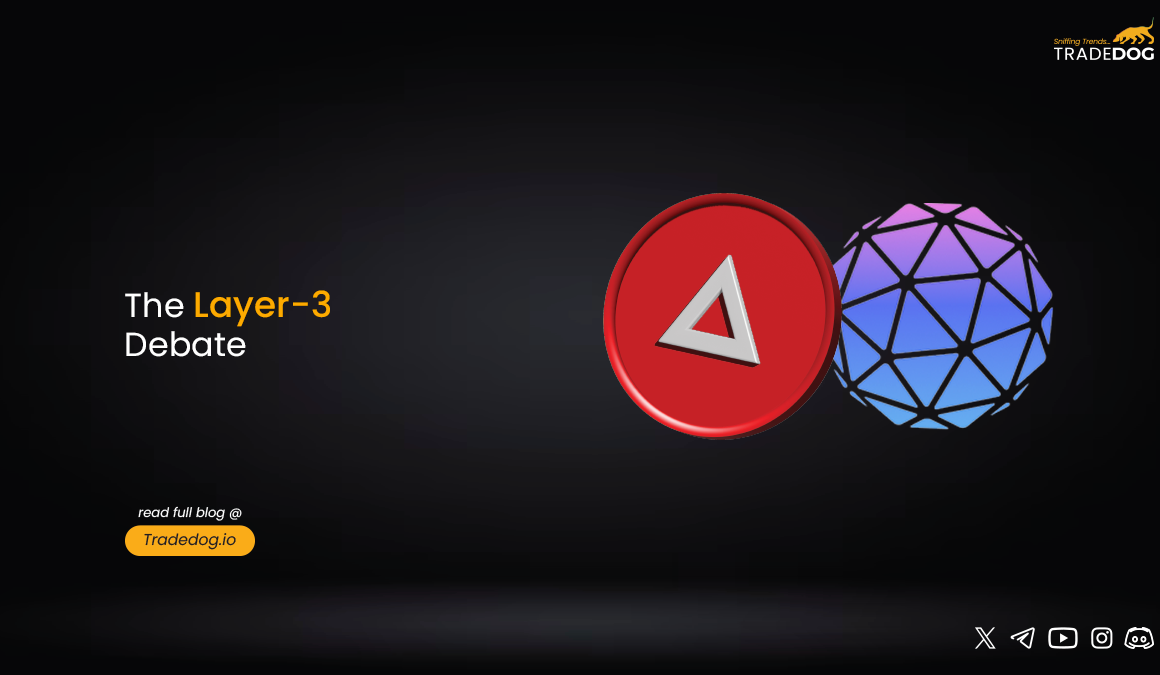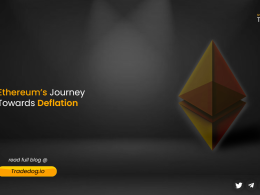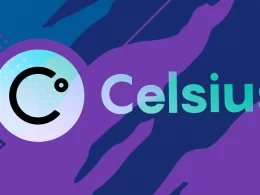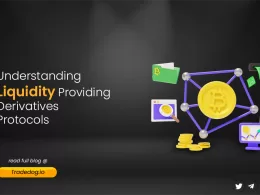Quick Links
In this blog, we will discuss what actually is a Layer-3 protocol, its value offering, comparison to Layer-2 infrastructure, available statistics around it, and most importantly, whether it is a solution that the market demands or another narrative which just caught up by the hype.
What are Layer-3 Protocols?
Layer 3 protocols are advanced systems created on top of Layer 2 solutions. They allow for more interaction between different platforms and are tailored to meet specific needs that developers might have. This can include addressing particular problems like privacy or handling a large number of transactions.
Despite their customization, Layer 3s still maintain the security offered by the foundational Layer 1 blockchain. These networks are specialized for individual decentralized applications, enabling them to function autonomously with their own set of rules, governance, and incentives. In order to understand its practical use case, let’s take a reference of an existing layer-3 protocol:
XAI is a layer-3 protocol on the Arbitrum ecosystem, designed to onboard traditional gamers to web3 gaming while improving their user experience on the platform. Through Xai, billions of traditional gamers can own and trade valuable in-game items in their favourite games for the first time without the need to use crypto wallets. The flexibility of onboarding users without a crypto wallet provides a fast, low-friction gaming experience, all while delivering the benefits of blockchain technology, including open trade, interoperability, composability, and item ownership.
Comparing Layer-3 with Layer-1 & Layer-2 Infrastructure
| Layer 1 | Layer 2 | Layer 3 | |
| Definition | Base layer of the blockchain | Developed on top of layer 1s | Host application-specific dApps |
| Primary Role | Secure and run the network | Reduce transaction costs and improve the scalability of base blockchain | Highly customizable dApps build to solve targeted issues |
| Scalability | Have scalability issues | Improved scalability as compared to layer 1 | Extremely Scalable |
| Interoperability | Isolated | Ability to interact | Enables different blockchains to work together |
| Transaction Fees | High | Low | Depending on the dApp |
| Use Cases | All functions related to blockchain | Transaction efficiency | Complex dApps with cross-chain functionality |
| Example | Ethereum | Polygon | Orbs |
Use-Cases of Layer 3 Protocols
The ultimate use cases of Layer 3 protocols based on the understanding revolves around scalability and user experience. We still have a long way to go to realize the potential of layer 3 protocols and their use cases. Based on some existing applications operating under layer 3, here are some identified use cases:
Infrastructure Scalability
Technical solutions offered by layer-3 infrastructure might solve the missing piece in the blockchain stack. How? The first layer ensures security in the blockchain system, while the second layer focuses on making transactions on the blockchain more scalable. Now, the third layer can play a crucial role in handling complex tasks and scripts that can’t be done by smart contracts alone. It offers them additional services to DeFi applications, making them more decentralized and capable.
Seamless GameFi Experience
Layer 3s find a compelling application in the world of blockchain gaming, where they come into play by providing a dedicated blockchain infrastructure. This dedicated blockchain not only accommodates a higher transaction volume but also significantly boosts transaction speeds. In the realm of gaming, where smooth in-game experiences are paramount, this becomes a critical advantage.
The gaming industry often needs to grapple with the intricacies of processing numerous microtransactions, which can be financially burdensome. Leveraging Layer 3 technology allows game developers to optimize cost-efficiency for their users, thanks to the reduced transaction fees associated with Layer 3s.
Customized DeFi Applications
Layer 3 technology is handy for decentralized finance (DeFi) apps. It lets developers customize these apps to suit their needs, adjust privacy settings, and add features. These Layer 3 systems are super fast, making them great for quick trading in DeFi. They also allow different blockchains to work together so that you can move your assets between them quickly.
Existing Layer-3 Protocols
As the concept of Layer-3 infrastructure is relatively new in the space, currently there are only a handful of protocols operating on this stack:
Orbs
Source: Orbs
Orbs is like a secure and open playground for blockchain technology. It runs on a network of validators who don’t need permission and uses a Proof-of-Stake system to make decisions. Imagine it as a middle layer that sits between other blockchain systems and the actual applications we use. It only moves money around a little. Think of Orbs as a supercharged computer for web apps. It makes regular and special smart contracts work better.
Xai
Xai is the first layer-3 in the Arbitrum ecosystem, designed to onboard traditional gamers to web3 gaming. We have already discussed Xai in the introduction of the blog.
Arbitrum Orbit
The Arbitrum Foundation released a new feature called Arbitrum Orbit in 2023. Hence, Arbitrum is currently making the most out of the layer-3 offerings. Orbit is envisioned as a layer-3 blockchain built on the top of the Arbitrum Nito platform. Apart from lower transaction costs and increased scalability, developers can create their self-managed specialized blockchain, which provides the flexibility to customize blockchains according to specific needs.
Focal Point: Is Layer-3 Required?
While some argue that Layer 3 could introduce added technical complexity and security risks to blockchain infrastructure, it’s essential to recognize the valuable role it plays in simplifying the intricate web3 environment. Undoubtedly, achieving a seamless user experience within decentralized applications remains a considerable challenge. Decentralized applications (Dapps) still have a substantial journey ahead before reaching mainstream adoption.
To underscore the complexity issue, let’s consider the trading volume shift from decentralized exchanges (DEXs) to centralized exchanges (CEXs). While there have been instances of DEXs surpassing CEXs in trading volume, these spikes have proven unsustainable over time. Notably, the FTX crash in November 2022 led to a significant surge in DEX trading volume due to regulatory uncertainties surrounding centralized exchanges. However, recent trends suggest a shift back towards centralized exchanges. This transition can be attributed, in part, to the fragmented user experience on DEXs as users navigate different chains, tokens, and wallets.
Nevertheless, if Layer-3 protocols can successfully address these user journey complexities within decentralized applications, they have the potential to revolutionize the web3 landscape. This innovation could lead to substantial growth for the protocols operating on Layer 3, making their native tokens an enticing investment prospect.
Closing Thoughts
In conclusion, the emergence of Layer-3 protocols in the blockchain space represents a promising frontier for scalability and user experience improvement. While Layer-1 ensures security and Layer-2 enhances transaction scalability, Layer-3 steps in to handle complex tasks and scripting, particularly benefiting DeFi applications.
In the world of gaming, Layer-3 offers faster and more efficient in-game experiences, while in the DeFi sector, it enables customized solutions with added privacy and speed. Although Layer-3 technology is relatively new, with protocols like Orbs and Xai leading the way, it has the potential to simplify the complex user experience in decentralized applications, potentially reshaping the future of web3. As the crypto landscape continues to evolve, the growth and investment prospects for Layer-3 protocols and their native tokens could be compelling.
The value offering of layer-2 protocols in terms of bringing more transaction scalability on the primary blockchain has gained significant validation from the crypto market, and a total TVL of $20.73 billion further validates it. However, the fast-paced technical aspects of blockchain always bring innovation to the table at regular intervals. From what it looks like, the Layer-3 narrative has started to take off to get more scalability to layer-2 protocols as well as enhance the user experience on decentralized applications.
In this blog, we will discuss what actually is a Layer-3 protocol, its value offering, comparison to Layer-2 infrastructure, available statistics around it, and most importantly, whether it is a solution that the market demands or another narrative which just caught up by the hype.









